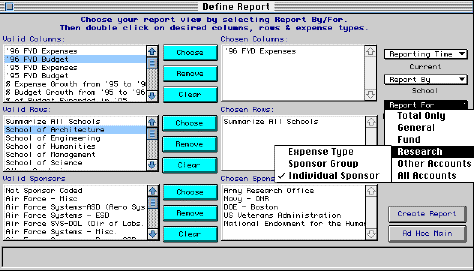Ad Hoc Reports
With $SumMIT ad hoc reports, you choose the report columns, rows, and expense types (= object code ranges) or sponsors from lists of possibilities.
The ad hoc reports run on current or historical accounts data. Current data includes FYTD actuals and budgets for the current and prior fiscal years. Historical data includes fiscal year-end data back to 1978.
The Ad hoc Define Report screen is shown below. The righthand boxes are initially blank.

To run an ad hoc report,
- Select Current or Historical data
(from Ad hoc main menu or Reporting Time popup menu, see
above) to determine valid report columns.
Result: Columns available are listed in upper lefthand screen box, as shown above.
- To determine valid rows, make a selection from
the Report By popup menu (see above).
For current data, the rows are schools, depts, groups, supervisors, or your authorized accounts. For historical data, the rows are limited to schools or departments.
Result: Valid report rows are listed in middle lefthand box.
- To run a report by sponsor, you need to select
Research then Sponsor Group or Individual sponsor
from the Report for popup menu (shown above).
Result: Expense types, sponsor groups, or individual sponsors are listed in lower lefthand box.
Note: To list object codes for an expense type, hold down (for PC users) Control or (for Mac users) Command, and double click on an expense type's line.
- To define a report,
- in lefthand boxes, highlight the columns/rows/expense types/sponsors to report on,
- click on Choose buttons to copy names of selected columns/rows/expense types/sponsors to righthand boxes.
- If you have not already done so, select an option
from the Report For popup menu, shown above.
The options available are to create one report on ALL account types (= default), one report on one of four account types (research, fund, general, or other = balance sheet) or all of the above (= five reports).
- (historical reports only) You can use the CPI Deflator
to deflate (or inflate) report dollars to match dollars for any fiscal
year back to 1978.
To do so, click on Use CPI Deflator, and then from popup FY menu, select a fiscal year to relate others to.
- Click on Create Report.
The Define Report screen saves your parameters so that you can edit and reuse them, if needed.